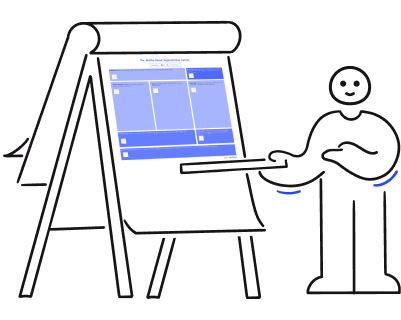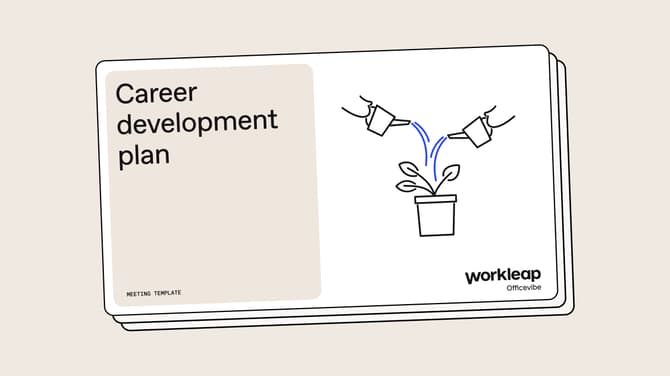Empower your organization with the skills-based canvas.

What's in this article
Mergers and acquisitions can be formidable chess moves that propel organizations forward. Think Microsoft's acquisition of LinkedIn or Facebook's acquisition of Instagram and WhatsApp. M&As can also all too often spell disaster, like NewsCorp’s spectacular fall with its MySpace sell or the very Googled Yahoo-Tumblr Failed Acquisition.
On paper, the courtship between two organizations can look highly synergistic and very promising. But if the peanut butter and jelly doesn’t gel well, then you're toast.
(Yes, the dad jokes are strong today.)
What makes or breaks beautiful M&A promises? People. It’s the employees, not the numbers, that make a business. In reality, M&A success is a function of the seamless integration of employees post-acquisition. Only then you can unlock true synergy (and make bankers deserve their bonuses).
According to a Harvard Business Review report highlighted in The Big Idea: The New M&A Playbook, between 70% and 90% of mergers and acquisitions fail to deliver their expected value. A major reason is the challenge of integrating two separate workforces into one harmonious team. Without a well-planned integration strategy, the post-acquisition transition can be a total disaster.
Integration is the key to a successful transition and unlocking synergies. Thankfully, companies can ensure a perfect match of talents for a successful (and smooth) post-acquisition transition with skill mapping.
In this article, we'll explore how companies like yours can use skill mapping to ensure a smooth and successful post-merger workforce integration.
The challenges of M&A
Playing a great game of chess requires foresight, coordination and a solid understanding of the strengths and weaknesses of each piece on both sides.. In the same way, M&A can be complex, and without the right strategy or planning, they can be even more time-consuming and expensive than you could’ve anticipated.
Culture fit: Merging companies with different cultures can feel like putting a square peg through a round hole. Conflicts or differences in values, work styles, and communication styles can lead to tension and hinder collaboration. It’s estimated that between 50—75% of mergers fail because of culture clashes alone.
🤼 Culture clash scenario: Say Company A has a laid-back and casual culture that values open communication and collaboration. Their employees enjoy flexible and remote work options. Company B however is traditional with a culture that values structure and hierarchy.
When these two companies merge, Company A's employees may feel stifled by Company B's rigid mentality, while Company B's employees may feel disorganized in Company A's more abstract structure. This can create an ‘us versus them’ internal culture HR leaders want to avoid.
- Changing roles and responsibilities: The post-acquisition transition can be a tricky move. In many cases, employees' roles and responsibilities will change after an acquisition. This can lead to—you guessed it—confusion, frustration, and a decrease in productivity.
- Redundancies: In some cases, there may be overlap between the two companies' workforces. How do you deal with two CFOs? Ill-managed redundancies lead to layoffs—a difficult reality for employees, that can cause emotional distress and damage a company's reputation.
- Post-acquisition turnover: If employees are unhappy with their new roles or feel undervalued, they may leave the company. This can be costly and impact the company's ability to deliver value from the acquisition.
Using skill mapping to ensure a successful post-acquisition workforce integration
Skill mapping is a process of identifying and assessing the skills and competencies of the workforce—like tuning each instrument in an orchestra.
What companies can look to achieve using skill mapping:
- Identify skills gaps: Skill mapping helps companies recognize areas where they lack expertise or talent, and a skills-based approach can help you better leverage a "build-buy-partner" framework to identify where to invest both internally and externally. This helps keep recruitment efforts focused, ensuring the right people are on board.
- Evaluate target companies: During due diligence (which occurs during the evaluation phase of the acquiring & merging), skill mapping helps companies assess the target company's workforce and identify areas of complementarity. This can help them make more informed decisions about whether to proceed with the acquisition.
- Integrate the acquired company's workforce: After the acquisition, skill mapping can be used to integrate the acquired company's workforce into the existing organization. This ensures that employees are deployed in roles that align with their skills and interests, reducing the risk of post-acquisition turnover.
How to use skill mapping for a successful post-acquisition workforce integration
Employees are the heartbeat of organizations. Their skills are therefore critical to an M&A deal. Beyond valuable IP, companies first and foremost acquire smaller companies for their know-how, culture, processes, and skills... in other words, their people!
Skill mapping, the understanding of what the key strengths and gaps are across the acquiring and acquired companies, is a surefire way to plan your consolidated workforce and understand how to best integrate newly acquired teammates.
Remember to consider the following:
Before the acquisition:
- Map your organization's skills: The first step in using skill mapping is to map your organization's skills. This will help you identify areas where you may be lacking in expertise or talent.
- Identify skills gaps: Once you've mapped your organization's skills, you can identify areas where you have skills gaps. This can help you focus your recruitment efforts and ensure that you have the right people in place to achieve your goals.
- Evaluate your options: If you've identified skills gaps, you'll need to evaluate your options for filling them. You can use a Build-Buy-Partner framework to evaluate your options. If buying is the most strategic decision, a clear assessment of your skills and gaps will help you narrow down on targets that are complementary—not just in terms of IP but also in terms of people.
👀 The importance of pre-acquisition analysis
If you're acquiring a company that specializes in a particular technology or product, you'll want to assess whether their workforce has the skills to integrate with your own technology stack or whether you'll need to hire additional personnel. Skill mapping can help you identify these gaps early on and develop a plan to address them — and help you foresee the cost of needed investment in technology and hiring short and long-term. These insights might help shed light on whether to move forward or not.
During the acquisition:
- Use skill mapping to assess the target company's workforce: This is a crucial step that can save companies from unpleasant surprises during the integration process. Assessing the target company's workforce will allow you to identify the skills gaps and overlaps, which can help you better determine the post-acquisition structure of the organization.
- Evaluate cultural fit: Culture fit is critical to the success of any M&A deal. The target company's culture needs to be evaluated in detail to ensure that it aligns with the acquiring company's culture. Differences in corporate cultures can lead to conflicts and a lack of cohesion among the workforce, which can ultimately affect productivity and hinder the success of the deal.
- Establish clear communication channels: Communication is key during the acquisition process. You'll need to establish clear communication channels between the acquiring and target companies to keep everyone on the same page. It's essential to keep everyone informed of any changes and progress made in the integration process. Setting up regular meetings and communication channels can help ensure that all parties are informed and on the same page throughout the integration process.
📣 From announcement, to milestone communication, to narrative building, an M&A communication strategy can be complex and its own headache. McKinsey outlines an easy blueprint for both internal and external communication strategy to accompany the M&A process here.
After the acquisition:
- Facilitate and accelerate the integration process using skill mapping: After the acquisition, you'll need to integrate the target company's workforce into the acquiring company's culture and structure. This process can be challenging and time-consuming, but skill mapping can help accelerate the process. By assessing the acquired company's workforce and identifying their skills, you can more easily integrate them into your own organization and put their talents to work in a way that benefits both parties. This can help to reduce frustration among employees and increase the likelihood of retaining key talent.
- Establish a clear post-acquisition plan: It's important to establish a clear post-acquisition plan to ensure that everyone is on the same page and that the integration process runs smoothly. This plan should outline the post-acquisition structure of the organization, including roles and responsibilities, and should be communicated to all employees. Having a clear plan in place can help to reduce confusion and ensure that everyone is working towards the same goals.
There are many success stories of M&As out there, and a skills-based approach can help companies reduce uncertainty and risk during the integration process.
Let skill mapping be the roadmap to identifying skill gaps, evaluating cultural fit, and speeding up the integration process. — helping you achieve a smooth transition and boost your chances of success.
Remember, M&A is a high-stakes game, and the stakes are only getting higher. In 2022 alone, the total value of M&A deals worldwide amounted to 3.8 trillion. But with the right approach and tools, companies can gain a significant advantage in the market and position themselves for success in the future.
Workleap Skills helps remove the guesswork from M&A deals
Like a dance, M&As are about knowing what strengths to play off of your partner in order for both parties to come together in shared rhythm and harmony. But sometimes, there are beats and steps harder to master, and that's where Skills comes in.
We help identify the skills gaps and cultural differences between acquiring and target companies. By mapping out the skills and evaluating cultural fit, you can ensure that everyone is dancing to the same tune. Sign up for a free trial!
Monitor, support, and optimize your team's professional development.




